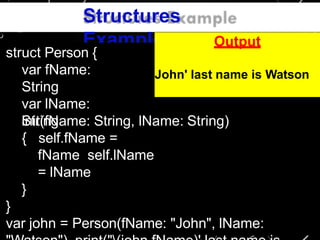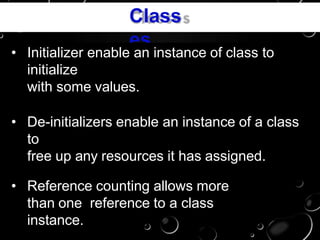Enumerations, structure and class IN SWIFT
- 1. Enumerati on ? An enumeration defines a common type for a group of related values. ? Enumerations in Swift are much more flexible as compared to other languages. ? You do not have to provide a value for each case of the enumeration. ? enum keyword is used to define an
- 2. Enumerati on ? The value of each case in enumeration can be a String, a character, an Integer or floating point number is called associated value. ? Enumerations are preferred over structures, when there is finite set of values. ? Similar to other languages enumerations in Swift can also have raw values.
- 3. Enumeration Syntax ? Syntax: enum EnumerationName: RawType { // enumeration definition goes here }
- 4. Enumeration Example enum WeakDays { case Monday case Tuesday case Wednesday case Thursday case Fridaycase Saturday, Sunday} case keyword is used to introduce new enumeration cases.
- 5. Enumeration Example ? Once you assign to an enum value, you can reassign to another value without re- specifying the enum name. ? Example: var enumVar = enum.case1 enumVar = .case2
- 6. Enumeration Exampleenum direction { case east, west, north, south } var move = direction.east switch move { case .east: print("Moving to east") case .west: print("Moving to west") case .north: print("Moving to north") case .south: Output Moving to east
- 7. Enumeration with raw values enum numbers:Int { case one = 1 case two = 2 case three = 3 } print(numbers.one.rawValu e) print(numbers.two.rawValu e) Output 1 2 3
- 8. Enumeration with raw values enum fruitColor:String { case mango = "Yellow" case apple = °∞Red" } print(fruitColor.mango.rawVal ue) print(fruitColor.apple.rawValu e) Output Yellow Red
- 9. Enumeration with raw values enum numbers:Int { case one = 1 case two, three } print(numbers.one.rawValu e) print(numbers.two.rawValu e) print(numbers.three.rawVal Output 1 2 3 Note: When integers are used for raw values, they auto-increment if no value is specified
- 10. Enumeration with raw valuesenum fruitColor:String { case mango = "Yellow" case apple = "Red" case orange } print(fruitColor.mango.rawVal ue) print(fruitColor.apple.rawValu e) Output Yellow Red orange Note: When Strings are used for raw values, they itself treat as raw value if no value is specified
- 11. Enumeration with raw valuesenum area:Float { case length = 1.0 case breadth } print(area.length.rawValue ) print(area.breadth.rawValu e) Output Error Note: When non-integers are used for raw values once, it is must to assign raw value for each case.
- 12. Enumeration with raw valuesenum area:Float { case length case breadth case dimensions } print(area.length.rawValue) print(area.breadth.rawValue) print(area.dimensions.rawVa lue) Output 0.0 1.0 2.0
- 13. Enumeration with Associated valuesenum enum1{ case name(String) case ageSal(Int,Int) } var person = enum1.name("Raman") person = .ageSal(26,30000) switch person { case .name(let n): print("Welcome (n)") case .ageSal(let n, let r): print("Age: (n), Salary: Output Age: 26 Salary: 30000
- 14. Associated Values Vs Raw Values Associated Values Raw Values Different Datatypes E.g: enum {10,0.8,"Hello"} Same Datatypes E.g: enum {10,35,50} Values are created based on constant or variable Values should be literals only Varies when declared each time Value for member is same, can°Øt be changed (i.e. immutable)
- 15. Structur es ? Structure can define properties to store values. ? Structure can define methods to provide functionality. ? Structure are always copied when they pass around in the code. ? Structure can define initializers to set up their initial state.
- 16. Structur es? Structure encapsulates data some related data values. ? Structure pass their members by the values not by reference. ? Structure can define subscripts to provide access to their values using subscript syntax.
- 17. Structures Example struct Laptop { var color = "Black" var processor = "i7" var price = 38000 } var dellD15 = Laptop() print(dellD15.color) print(dellD15.process Output Black i7 38000
- 18. Structures with subscriptstruct multi { let m: Int subscript(i: Int) -> Int { return m * i } } let result = multi(m: 2) print(result[8]) Output 16
- 19. Structures Example struct Person { var fName: String var lName: Stringinit(fName: String, lName: String) { self.fName = fName self.lName = lName } } var john = Person(fName: "John", lName: Output John' last name is Watson
- 20. Class es ? A class is a blueprint or template for an instance of that class. ? The term "object" is often used to refer to an instance of a class. ? In Swift, however, classes and structures are very similar, and therefore it's easier and less confusing to use the term
- 21. Class es ? A class is collection of properties and methods. ? Classes in Swift are of reference type. ? Classes having all the things that structure have and some additional features also. ? Type casting enables you to check and interpret the type of a class instance at
- 22. Class es ? Initializer enable an instance of class to initialize with some values. ? De-initializers enable an instance of a class to free up any resources it has assigned. ? Reference counting allows more than one reference to a class instance.
- 23. Class Exampleclass Person { var age = 20 var gender = "Male" var name = "Raman" func show() { print(age) print(gende r) print(name) } } Output 20 Male Raman
- 24. Initializer and De- initializer ? Initializer enable an instance of class to initialize with some values. ? To create an initial value. ? To assign default property value within the property definition. ? To initialize an instance for a particular data type 'init()' is used. ? De-initializers enable an instance of a class to free up any resources it has assigned.
- 25. Class with init Exampleclass Person { var age:Int var gender:String var name:String init() { age = 20 gender = "male" name = "Raman" } Output } 20 Male Raman func show() { print(age) print(gende r) print(name) } var ob =
- 26. init having parametersclass Person{ var fName: String var lName: String init(fName: String, lName: String){ self.fName = fName self.lName = lName } func show() {print("Welcome (fName) (lName).") } } var ram = Person(fName:"Ram",lName:"Sharma") ram.show() Output Welcome Ram Sharma. self property to refer to the current instance
- 27. init and deinit Examplevar cnt = 0 // for reference counting class myClass { init() { cnt = cnt+1 } deinit { cnt = cnt-1 } } var ob:myClass? = myClass() print(cnt) ob = nil print(cn Output 1 0
- 28. Identity Operator ? Used to find out if two constants or variables refer to exactly the same instance of a class or not. ? For this two types of operators are there: ? Identical to (===) ? Not identical to (!==)
- 29. Identity Operatorclass Person { var age = 20 } var ram = Person() print(ram.age) var sham = Person() print(sham.age) print(ram === sham) print(ram !== sham) Output 20 20 false true
- 30. Identity Operator Exampleclass Person { var age = 20 } var ram = Person() print(ram.age) var sham = ram print(sham.ag e) print(ram === sham) Output 20 20 true false

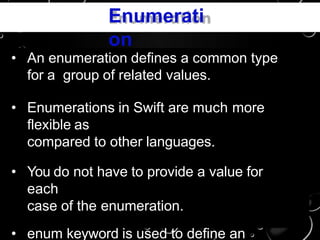
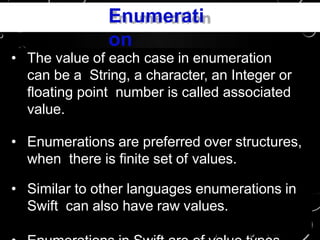


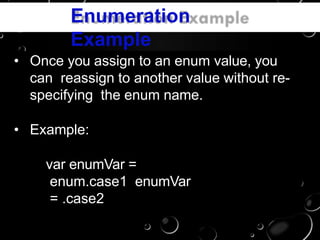
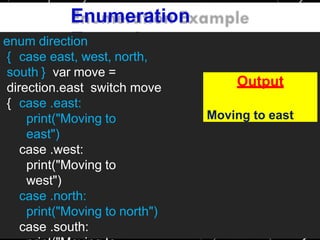

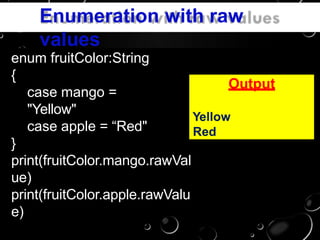
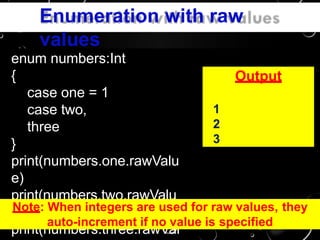
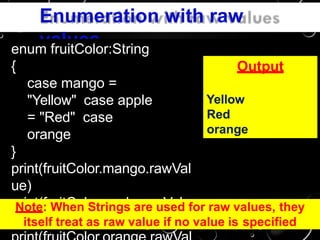

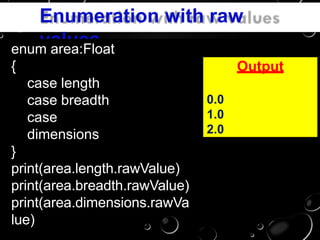
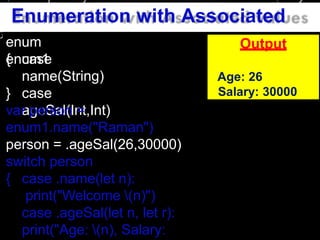
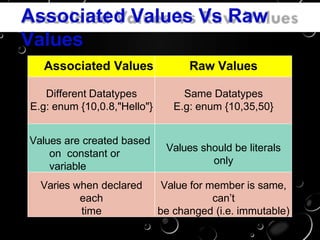
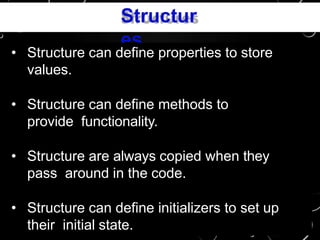
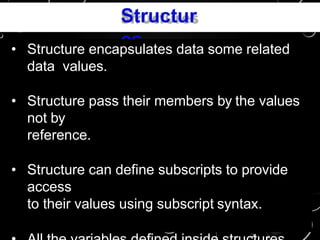

![Structures with
subscriptstruct multi
{ let m: Int
subscript(i: Int) ->
Int
{
return m * i
}
}
let result = multi(m:
2) print(result[8])
Output
16](https://image.slidesharecdn.com/enumerationsstructureandclass-200515133939/85/Enumerations-structure-and-class-IN-SWIFT-18-320.jpg)
